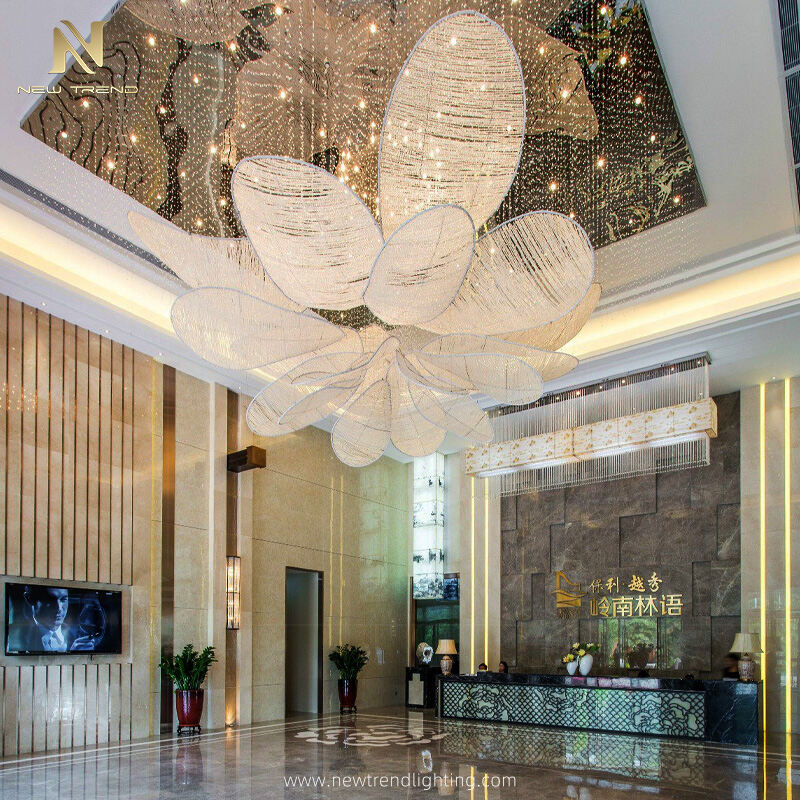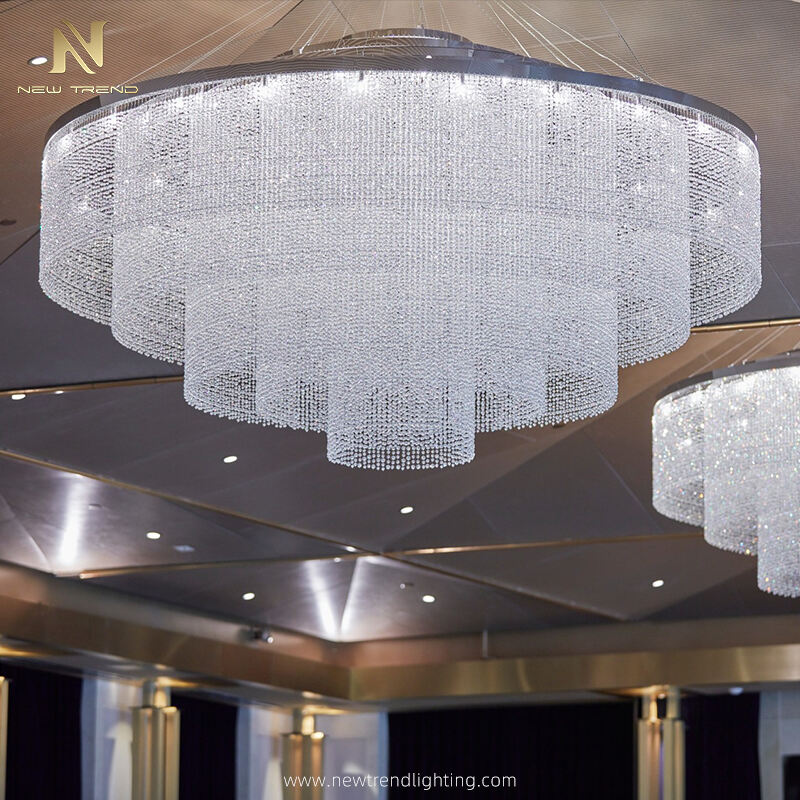KAN Op maat gemaakte verlichting Minimalistische architectuur aanvullen
Minimalistische architectuur staat bekend om zijn schone lijnen, onoverzichtelijke ruimtes en nadruk op functie boven decoratie. Het streeft ernaar om overbodigheid te elimineren en zich te richten op eenvoud, waarbij vaak gebruik wordt gemaakt van een beperkt palet aan materialen en kleuren om kalme, verfijnde omgevingen te creëren. Binnen dit kader is de rol van verlichting niet alleen praktisch, maar ook diepgaand esthetisch. De vraag die zich stelt is of op maat gemaakte verlichting , vaak geassocieerd met geïndividualiseerde, unieke en soms uitgebreide oplossingen, kan in harmonie zijn met minimalistische designprincipes. Op het eerste gezicht lijken de concepten tegenstrijdig. Minimalisme hecht waarde aan terughoudendheid, terwijl op maat gemaakte ontwerpen vaak individualiteit en expressie uitdrukken. Maar met zorgvuldige planning en doordachte integratie kan op maat gemaakte verlichting niet alleen aansluiten bij minimalistische architectuur, maar deze ook verheffen.
Inzicht in op maat gemaakte verlichting
Op maat gemaakte verlichting verwijst naar verlichtingsarmaturen en systemen die speciaal zijn ontworpen of afgestemd op specifieke projecten. In tegenstelling tot geïndustrialiseerde verlichting worden op maat gemaakte oplossingen gecreëerd met specifieke architectonische ruimtes, gebruikersbehoeften of esthetische doelstellingen in gedachten. Dit kan unieke materialen, afmetingen of configuraties omvatten die niet beschikbaar zijn in standaardcatalogi. De waarde van op maat gemaakte verlichting ligt in haar vermogen om direct te reageren op het architectonische karakter van een ruimte en de persoonlijkheid van haar gebruikers te weerspiegelen.
In de minimalistische architectuur, waarin elk detail telt en visuele rompslomp moet worden vermeden, biedt op maat gemaakte verlichting een manier om precisie en harmonie te bereiken. In plaats van het opleggen van ornamentale ontwerpen, kunnen op maat gemaakte verlichtingstoestellen worden vervaardigd om naadloos samen te smelten met schone lijnen of om subtiel accenten te voorzien die de minimalistische sfeer versterken in plaats van verstoren.
Het verband tussen minimalisme en verlichting
Minimalistische architectuur is sterk afhankelijk van natuurlijk licht, open ruimtes en een teruggeschroefde toepassing van materialen. Kunstdaglicht in dergelijke ruimtes dient niet overheersend te zijn, maar het architectonische concept te ondersteunen. Een slecht gekozen verlichtingsarmatuur kan al te gemakkelijk een minimalistische ruimte overschaduwen, terwijl een goed doordachte lichtbron de rust en balans ervan kan versterken.
In dit verband biedt op maat gemaakte verlichting de flexibiliteit om precies te leveren wat de architectuur vereist. Of het nu een inbouwspot is die in het plafond verdwijnt, een lineaire hanglamp die de geometrie van de ruimte reflecteert, of een onzichtbaar schijnwerpersysteem dat in de houtwerk is opgenomen, op maat gemaakte oplossingen maken het mogelijk om verlichting minimalistische principes te laten volgen en toch voldoende verlichting te bieden.
Op maat gemaakte verlichting als uitbreiding van het minimalistische filosofie
Minimalistische architectuur benadrukt het aanpassen van het ontwerp aan de functie. Op maat gemaakte verlichting volgt hetzelfde principe. In plaats van gebruik te maken van standaardarmaturen die mogelijk niet passen bij de afmetingen van een specifieke ruimte, kan op maat gemaakte verlichting worden ontworpen om gerichte verlichting te bieden zonder overbodig visueel gedoe. In een minimalistische keuken kan bijvoorbeeld een lang lineair hanglamp ontworpen worden dat specifiek aansluit bij de lengte van het eiland, voor gelijkmatige werkverlichting terwijl het de geometrie van de ruimte benadrukt. In een minimalistische woonkamer kunnen ingebouwde op maat gemaakte lampen in nissen worden geïnstalleerd om architectonische volumes te accentueren zonder visuele rommel te introduceren.
Wat maatwerkverlichting met name compatibel maakt met minimalisme, is het vermogen om onopdringerijk te zijn. Op maat gemaakte verlichting kan worden ontworpen om in de architectuur te verdwijnen, zodat alleen het effect van het licht zichtbaar blijft. Op deze manier respecteert maatwerkverlichting de minimalistische leuze "minder is meer", terwijl het ruimte functioneel en expressief blijft.

Materiaalkeuzes en afwerkingen
Minimalistische architectuur maakt vaak gebruik van een beperkt materiaalpalet, zoals beton, hout, staal en glas. Maatwerkverlichting kan worden ontworpen om in harmonie te verkeren met deze keuzes. Bijvoorbeeld kunnen armaturen van geborsteld staal de koele toon van betonnen oppervlakken reflecteren, terwijl houten accenten in verlichting kunnen harmoniëren met eikenhouten vloeren of kasten. Matte afwerkingen worden in het minimalisme vaak verkozen, omdat ze reflecties en onnodige visuele afleidingen vermijden. Maatwerkverlichting stelt ontwerpers in staat afwerkingen te kiezen die naadloos integreren met de architectonische materialen, waardoor visuele cohesie in de gehele ruimte wordt gewaarborgd.
Ruimtelijke Integratie en Schaal
Schaal is nog een cruciaal aspect in minimalistisch ontwerp. Een kroonluchter die te groot of te gedecoreerd is, zou er niet op zijn plaats lijken in een ruimte die gekenmerkt wordt door terughoudendheid. Op maat gemaakte verlichting biedt nauwkeurige controle over afmetingen en proporties. Aangepaste hanglampen kunnen kleiner worden gemaakt om te passen bij intieme eetruimtes of juist worden uitgerekt om de lengte van een gang te overspannen. Inbouwverlichtingssystemen kunnen worden ontworpen om perfect uit te lijnen met plafondvoegen of wandpanelen, waardoor het gevoel van orde en precisie dat minimalisme vereist, wordt versterkt.
In ruimtes met een dubbele hoogte kan op maat gemaakte verlichting verticale accenten introduceren zonder de architectuur te overweldigen. Een reeks slanke lineaire hanglampen kan bijvoorbeeld de schaal van de ruimte benadrukken terwijl de eenvoud behouden blijft. Dergelijke maatwerkoplossingen tonen aan hoe op maat gemaakte verlichting ruimtes kan verfraaien in plaats van de minimalistische stijl tegen te spreken.
Op Maat Gemaakte Verlichting als Statementstuk
Minimalisme benadrukt terughoudendheid, maar sluit expressie niet uit. Sterker nog, zorgvuldig gekozen statementstukken kunnen centrale punten worden die de puurheid van het ontwerp versterken. Een op maat gemaakte kroonluchter met een sculpturale maar eenvoudige vorm kan dienen als kunstwerk in een minimalistische interieur. Het sleutelaspect is om durf te combineren met eenvoud. In plaats van gedetailleerde versieringen kan een minimalistische kroonluchter gebruikmaken van zuivere geometrische vormen, zoals bollen of lineaire staven, geordend in een opvallende maar gestructureerde compositie. Op deze manier kan op maat gemaakte verlichting persoonlijkheid toevoegen zonder de rust van de ruimte te verstoren.
Functionaliteit en sfeer
Verlichting in minimalistische architectuur gaat niet puur om zichtbaarheid; het gaat om het creëren van sfeer. Op maat gemaakte verlichting kan worden ontworpen om gelaagde verlichting te bieden, waardoor ruimtes zich kunnen aanpassen aan verschillende functies en stemmingen. Dimbare LED-systemen kunnen bijvoorbeeld een zachte ambientverlichting creëren voor ontspanning of heldere, gefocusseerde verlichting voor werkzaamheden. Verborgen lichtbronnen die in schappen, trappen of wandpanelen zijn opgenomen, kunnen subtiel diepte toevoegen en structuren benadrukken. Omdat op maat gemaakte verlichting is afgestemd op de ruimte, zorgt deze ervoor dat de functie van de ruimte wordt ondersteund, zonder onnodige armaturen of rommel toe te voegen.
Casestudies in minimalistische ruimtes
Overweeg een minimalistische galerieruimte waarin de architectuur bestaat uit zuiver witte muren en open volumes. Standaardverlichting zou visueel kunnen storen, maar op maat gemaakte schijnwerpersystemen die in het plafond zijn ingebouwd, kunnen flexibele verlichting bieden die pas zichtbaar wordt als ze worden geactiveerd. In een minimalistisch thuiskantoor kan een op maat ontworpen bureaulamp met een slank lineair ontwerp gerichte verlichting bieden zonder de opgeruimde bureaubodem te verstoren. In moderne, minimalistische badkamers creëren op maat gemaakte achterverlichte spiegels en in de muur verwerkte verlichting een sfeer zoals in een spa, zonder dat daarvoor afzonderlijke decoratieve armaturen nodig zijn. Elk van deze voorbeelden laat zien hoe verlichting op maat naadloos kan worden aangepast aan minimalistische eisen.
Conclusie
Op maat gemaakte verlichting en minimalistische architectuur lijken op het eerste gezicht misschien tegenstrijdig, maar in werkelijkheid delen zij een gemeenschappelijke filosofie: een toewijding aan functie, precisie en het wegwerken van overbodigheid. Indien zorgvuldig ontworpen, versterkt op maat gemaakte verlichting de puurheid van minimalistische ruimtes door gerichte verlichting te bieden die de functie ondersteunt en toch eenvoud respecteert. Het kan opgaan in de architectuur of dienen als een teruggeschroefd accentstuk, en draagt altijd bij aan balans en harmonie. Door het afstemmen van materialen, schaal en sfeer op de architectonische intentie, past op maat gemaakte verlichting zich niet alleen aan bij minimalistische architectuur, maar verheft het deze ook.
FAQ
Wat is op maat gemaakte verlichting?
Het betreft op maat ontworpen verlichtingsarmaturen en systemen die specifiek zijn ontwikkeld voor een project, in tegenstelling tot massaproductie.
Waarom is op maat gemaakte verlichting geschikt voor minimalistische architectuur?
Omdat het kan worden afgestemd op schaal, materiaal en functie, voegt het zich naadloos bij de minimalistische principes van eenvoud en precisie.
Kan op maat gemaakte verlichting een stijlstatement maken in minimalistische interieurs?
Ja, maar het statement wordt meestal gerealiseerd door eenvoudige geometrische vormen en gebalanceerde proporties, in plaats van ornamenten.
Welke materialen zijn het beste geschikt voor op maat gemaakte verlichting in minimalistische ruimtes?
Matte afwerkingen, geborstelde metalen, natuurhout en glas zijn populaire keuzes die goed aansluiten bij minimalistische materialen zoals beton en staal.
Hoe verbetert op maat gemaakte verlichting de functionaliteit?
Het stelt een aangepaste plaatsing, helderheidsregeling en integratie in architectonische elementen mogelijk, waardoor ruimtes zowel praktisch als sfeervol worden.
Is op maat gemaakte verlichting duurder dan standaard verlichting?
Ja, het is over het algemeen duurder vanwege het aangepaste ontwerp en ambachtelijke uitvoering, maar het biedt op lange termijn waar voor geld door perfecte integratie en kwaliteit.
Kan op maat gemaakte verlichting verborgen worden in een minimalistisch ontwerp?
Absoluut, het kan ingesnoerd worden, in meubelwerk worden opgenomen of worden ontworpen met onzichtbare elementen zodat alleen het lichteffect zichtbaar is.
Zijn op maat gemaakte kroonluchters geschikt voor minimalistische ruimtes?
Ja, mits zij worden uitgevoerd met schone lijnen, eenvoudige geometrie en gebalanceerde proporties, kunnen zij dienen als subtiel maar opvallend accentstuk.
Werkt op maat gemaakte verlichting in kleine minimalistische ruimtes?
Ja, het kan op maat worden gemaakt om precies in kleine ruimtes te passen, waarbij rommel wordt vermeden en tegelijkertijd effectieve verlichting wordt geboden.
Hoe draagt op maat gemaakte verlichting bij aan de sfeer in minimalisme?
Via dimbare systemen, verborgen lichtbronnen en afgestemde helderheid versterkt het de rustgevende en aanpasbare sfeer van minimalistische interieurs.
Inhoudsopgave
- Inzicht in op maat gemaakte verlichting
- Het verband tussen minimalisme en verlichting
- Op maat gemaakte verlichting als uitbreiding van het minimalistische filosofie
- Materiaalkeuzes en afwerkingen
- Ruimtelijke Integratie en Schaal
- Op Maat Gemaakte Verlichting als Statementstuk
- Functionaliteit en sfeer
- Casestudies in minimalistische ruimtes
- Conclusie
-
FAQ
- Wat is op maat gemaakte verlichting?
- Waarom is op maat gemaakte verlichting geschikt voor minimalistische architectuur?
- Kan op maat gemaakte verlichting een stijlstatement maken in minimalistische interieurs?
- Welke materialen zijn het beste geschikt voor op maat gemaakte verlichting in minimalistische ruimtes?
- Hoe verbetert op maat gemaakte verlichting de functionaliteit?
- Is op maat gemaakte verlichting duurder dan standaard verlichting?
- Kan op maat gemaakte verlichting verborgen worden in een minimalistisch ontwerp?
- Zijn op maat gemaakte kroonluchters geschikt voor minimalistische ruimtes?
- Werkt op maat gemaakte verlichting in kleine minimalistische ruimtes?
- Hoe draagt op maat gemaakte verlichting bij aan de sfeer in minimalisme?



